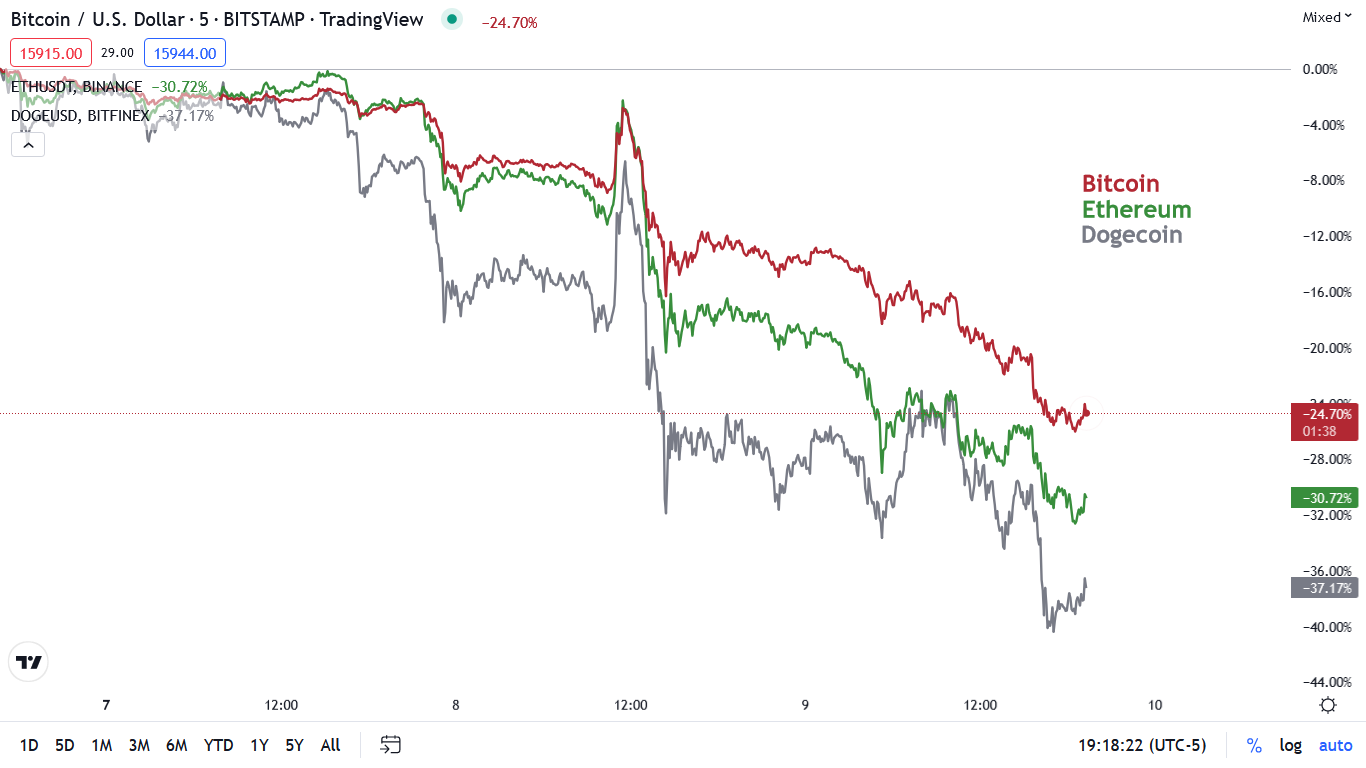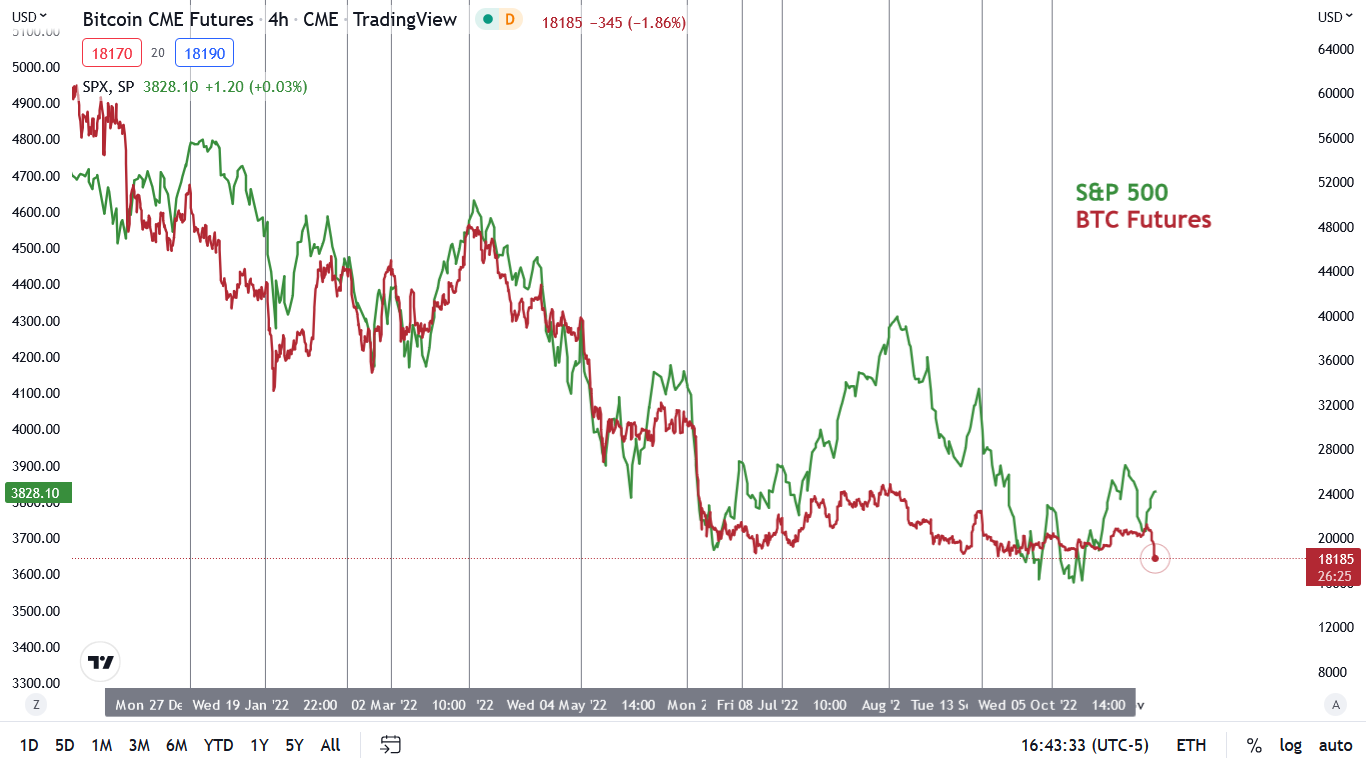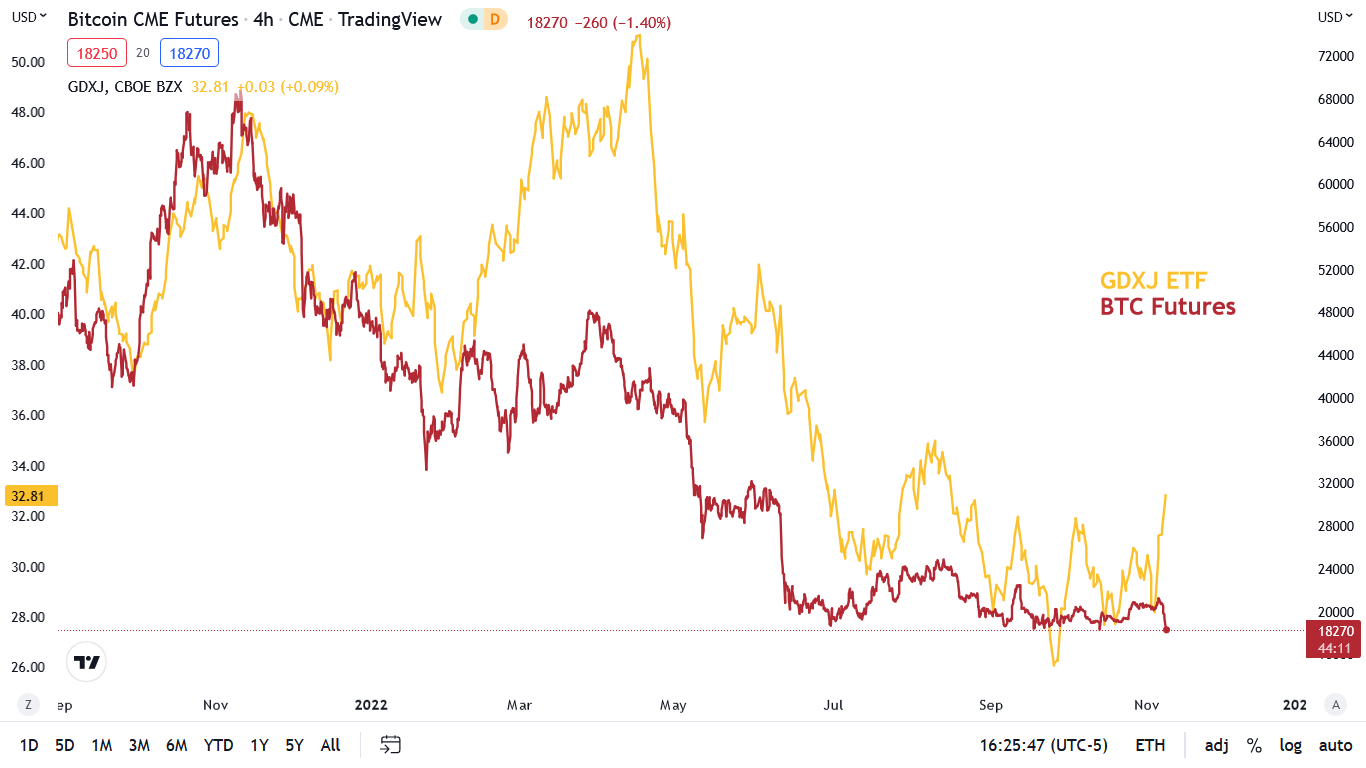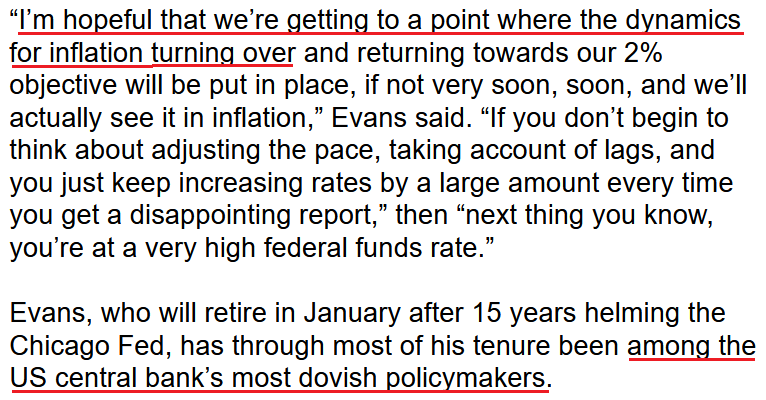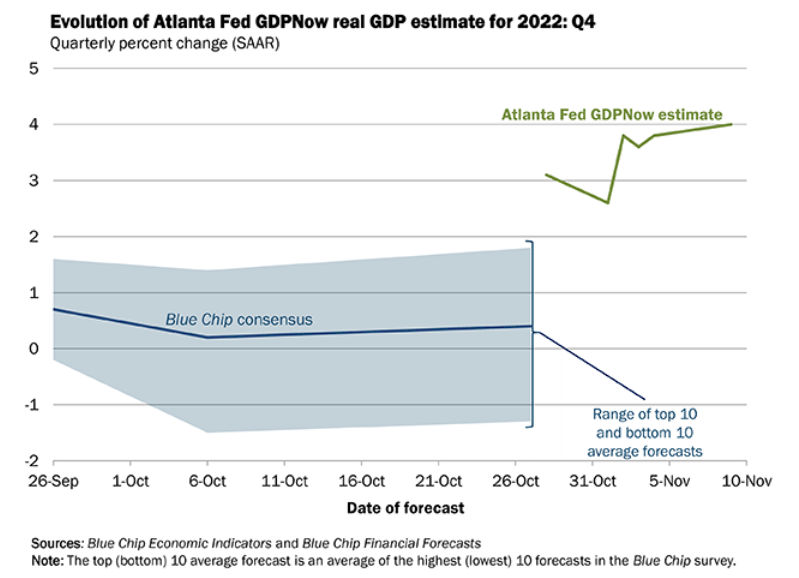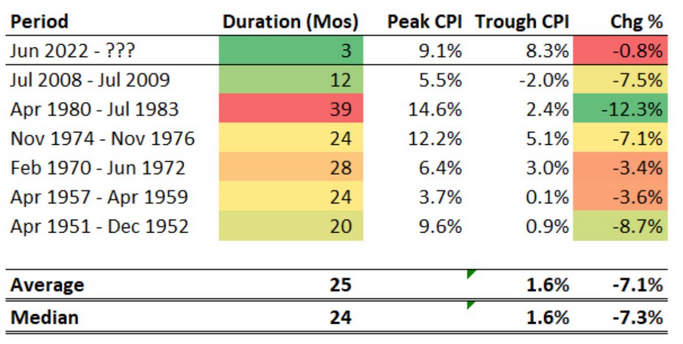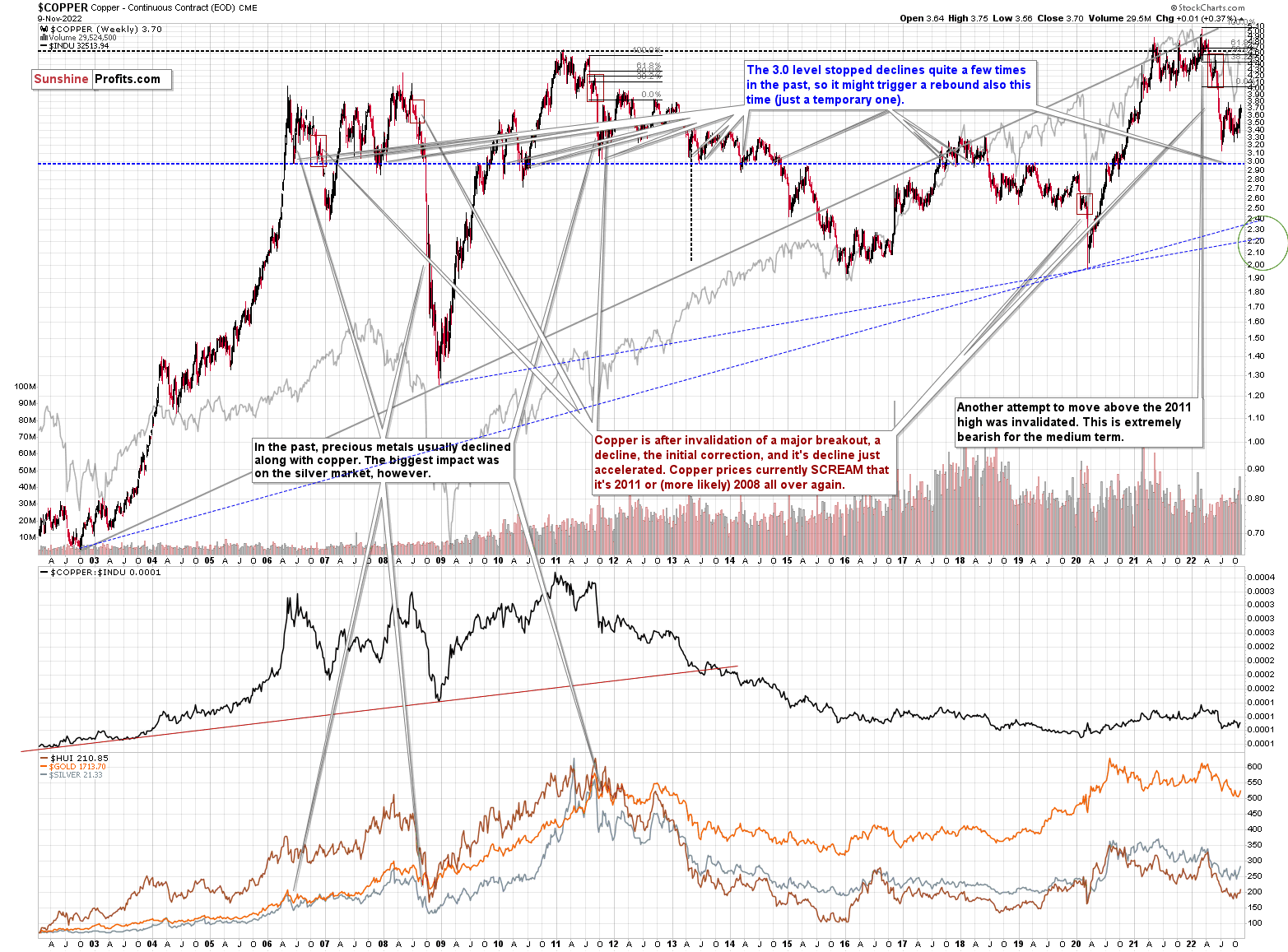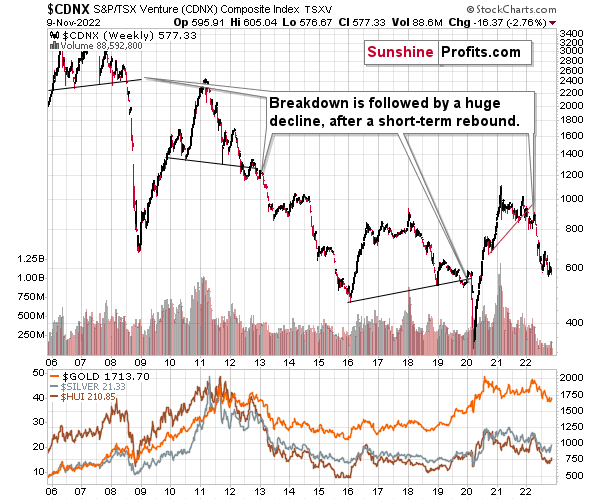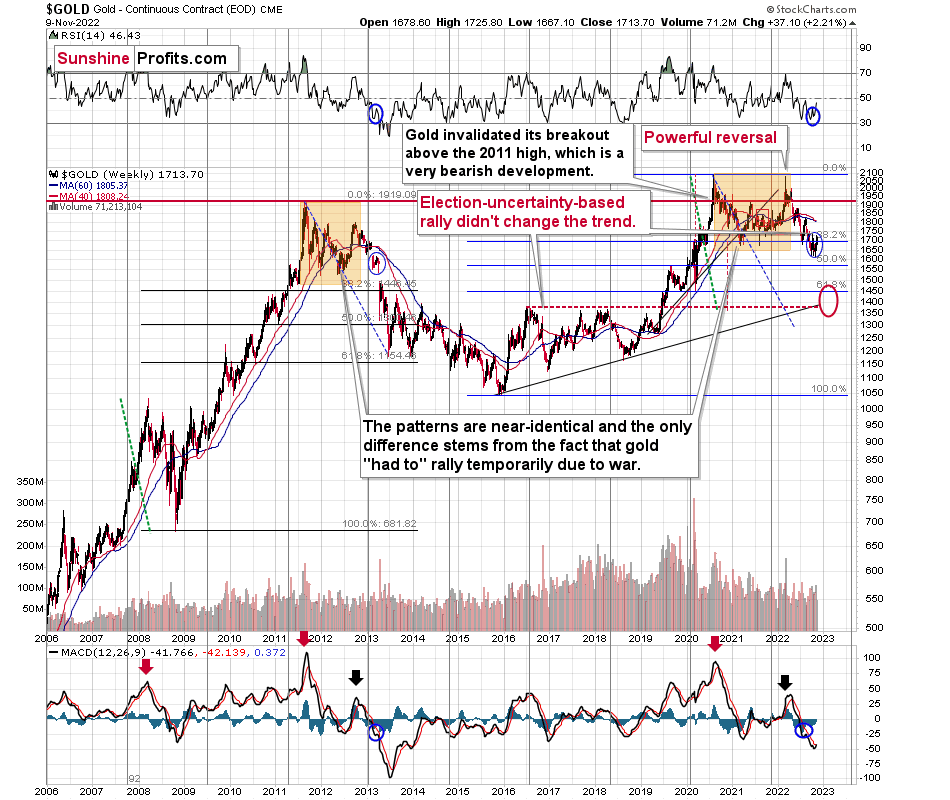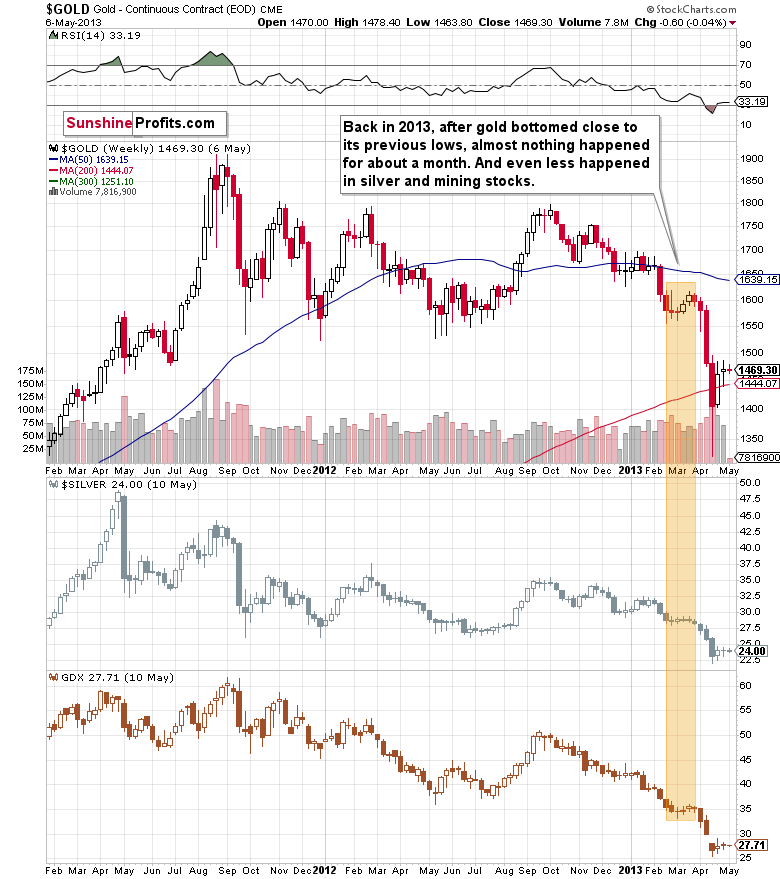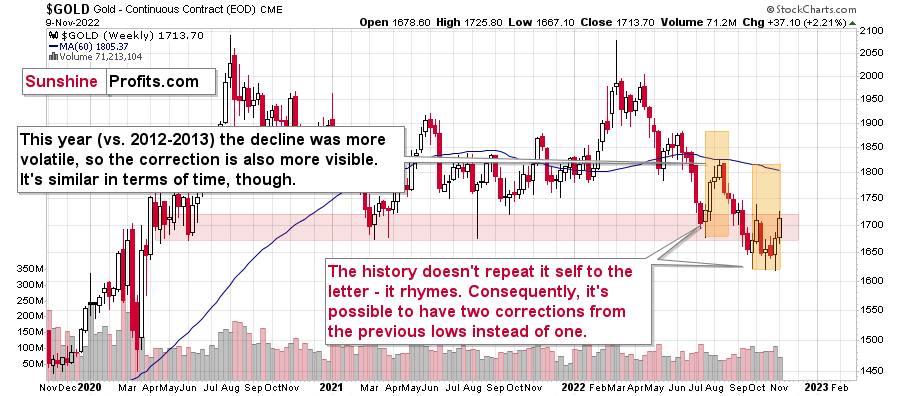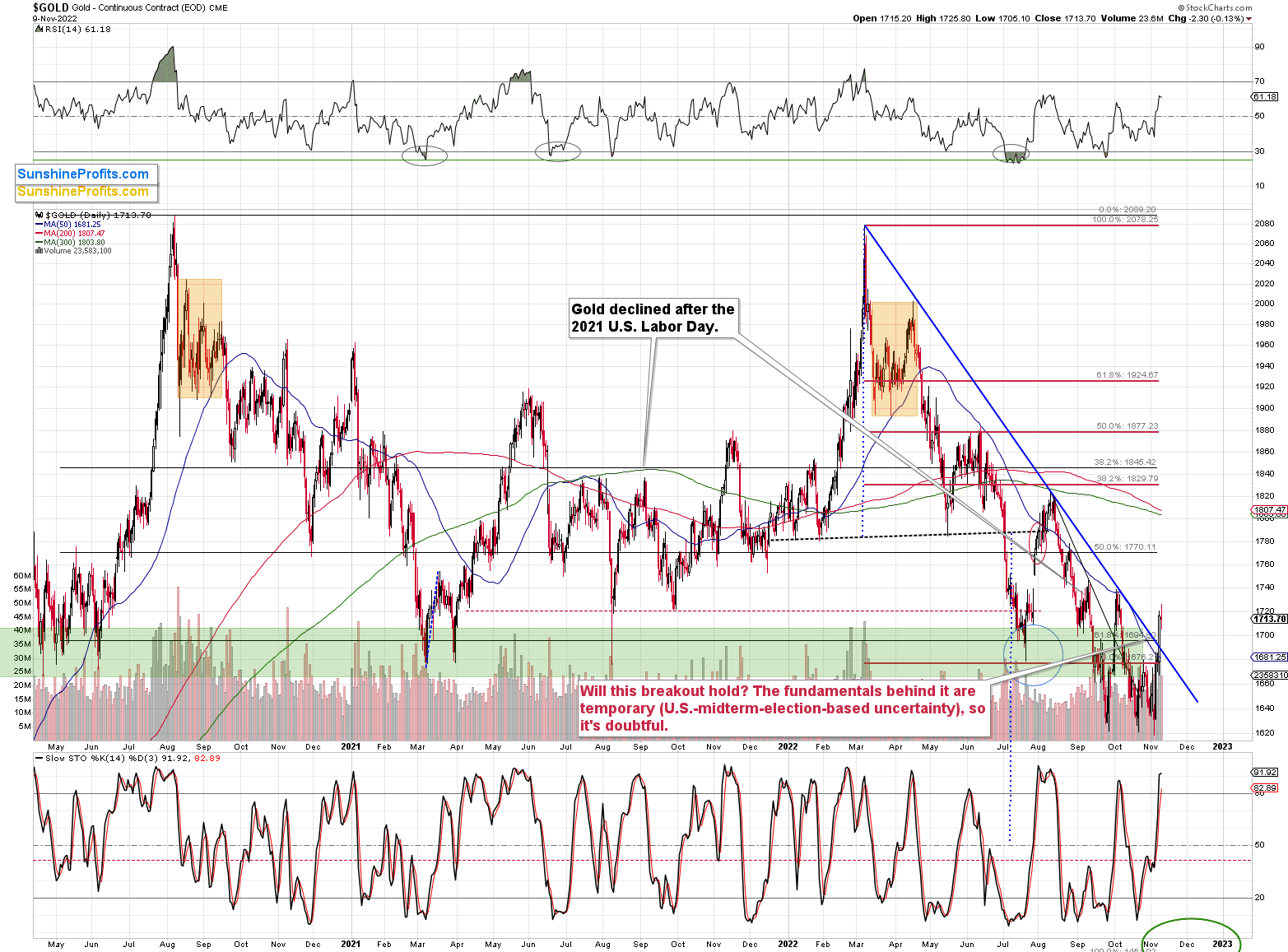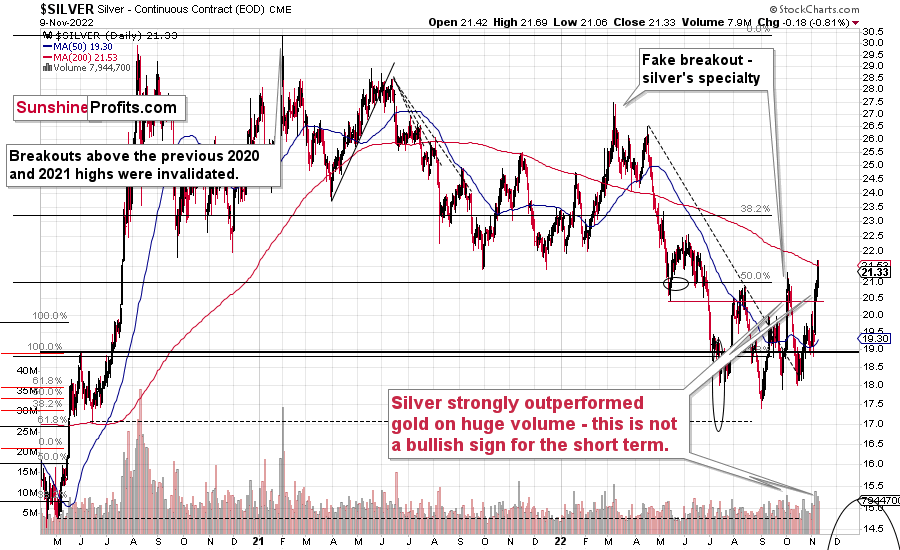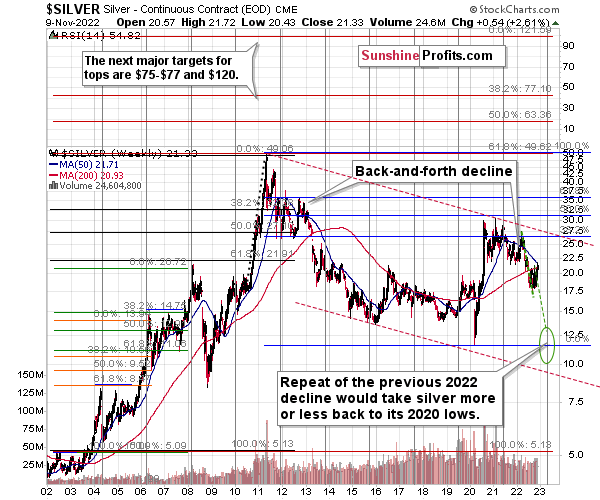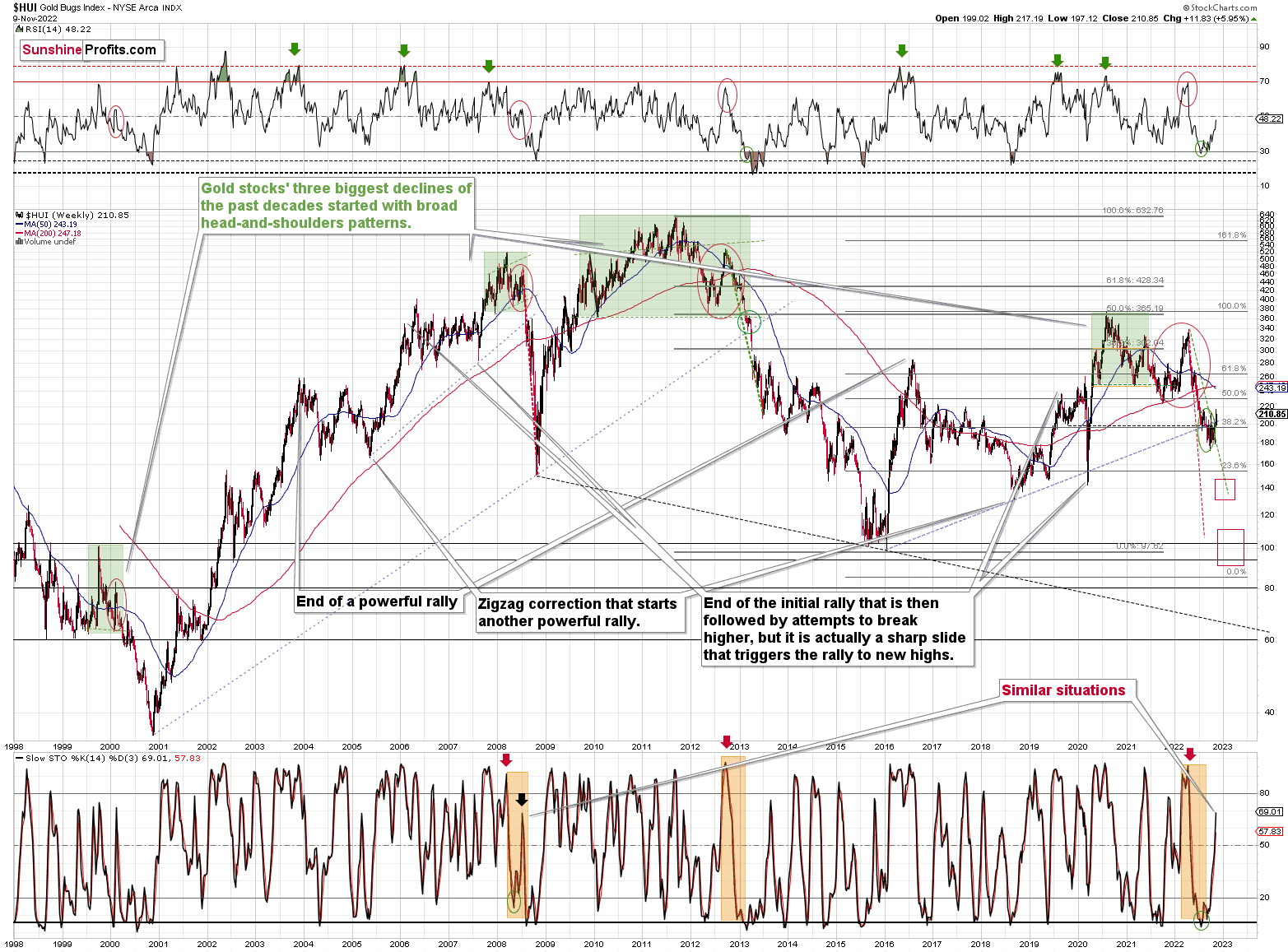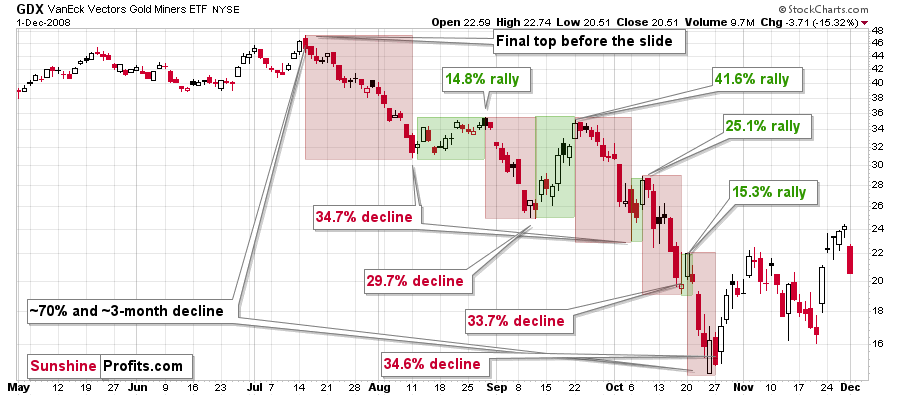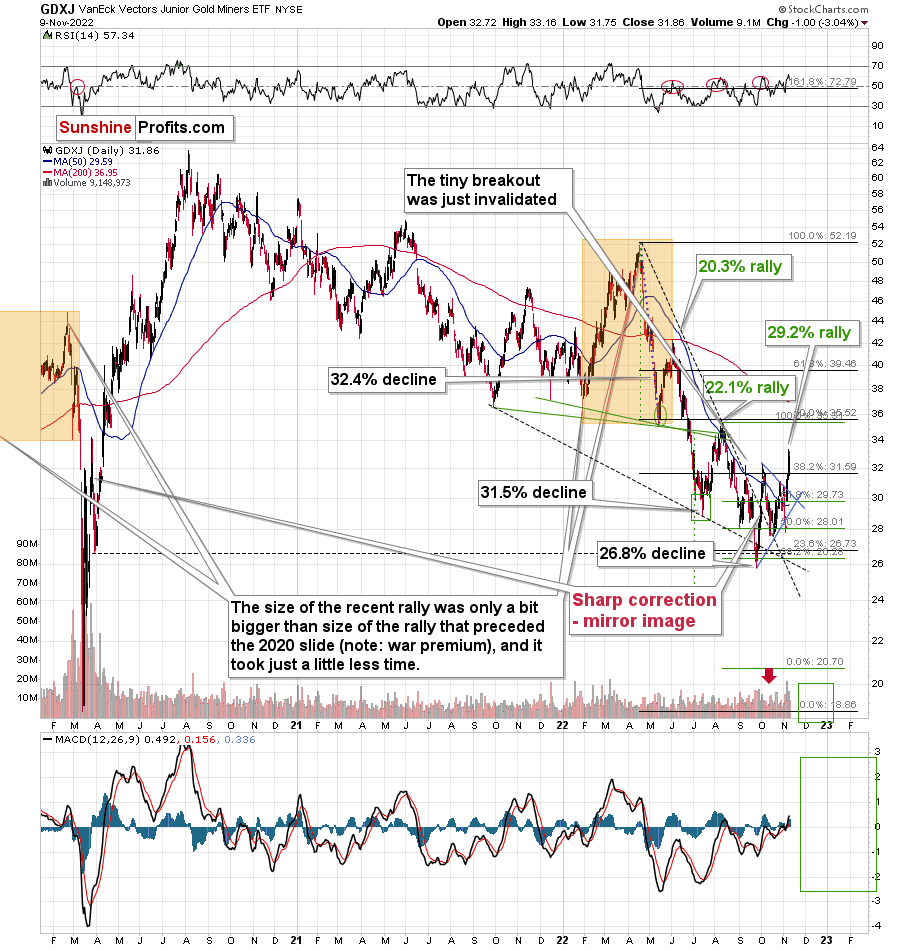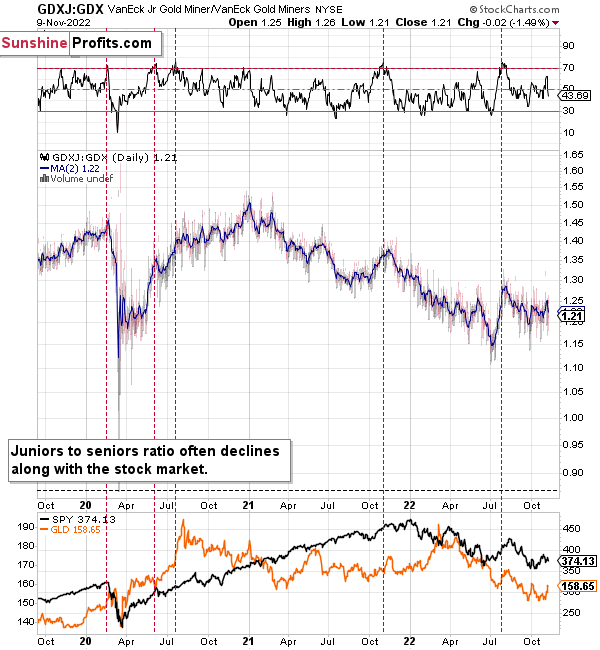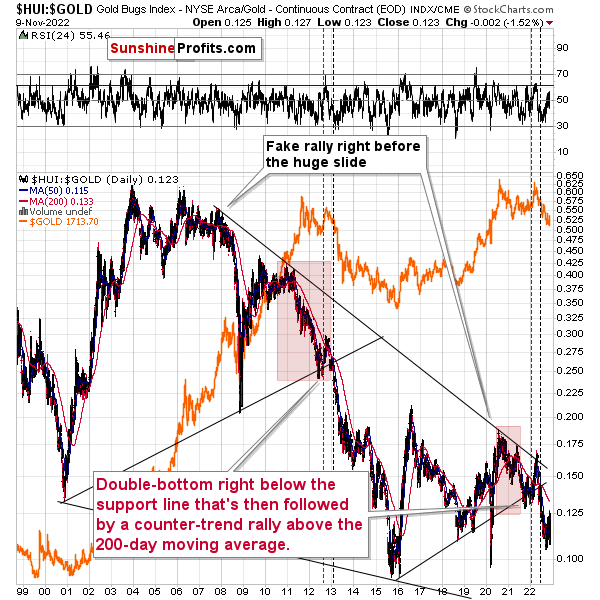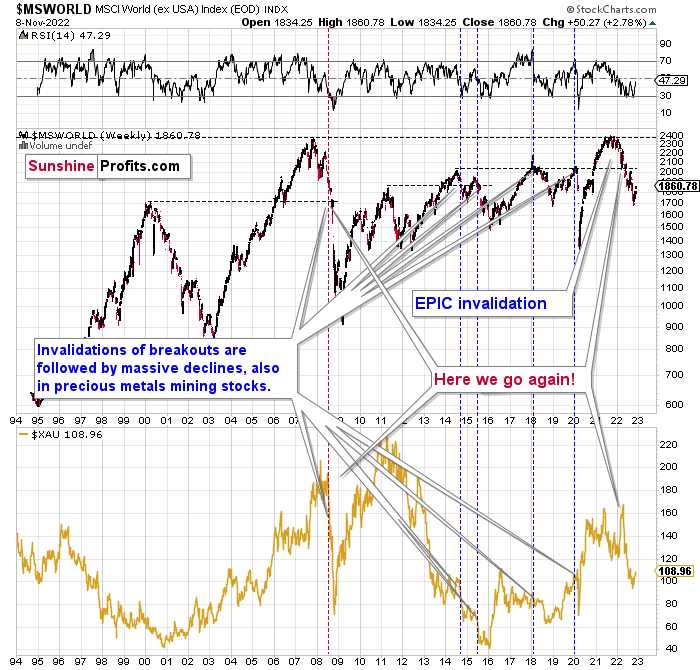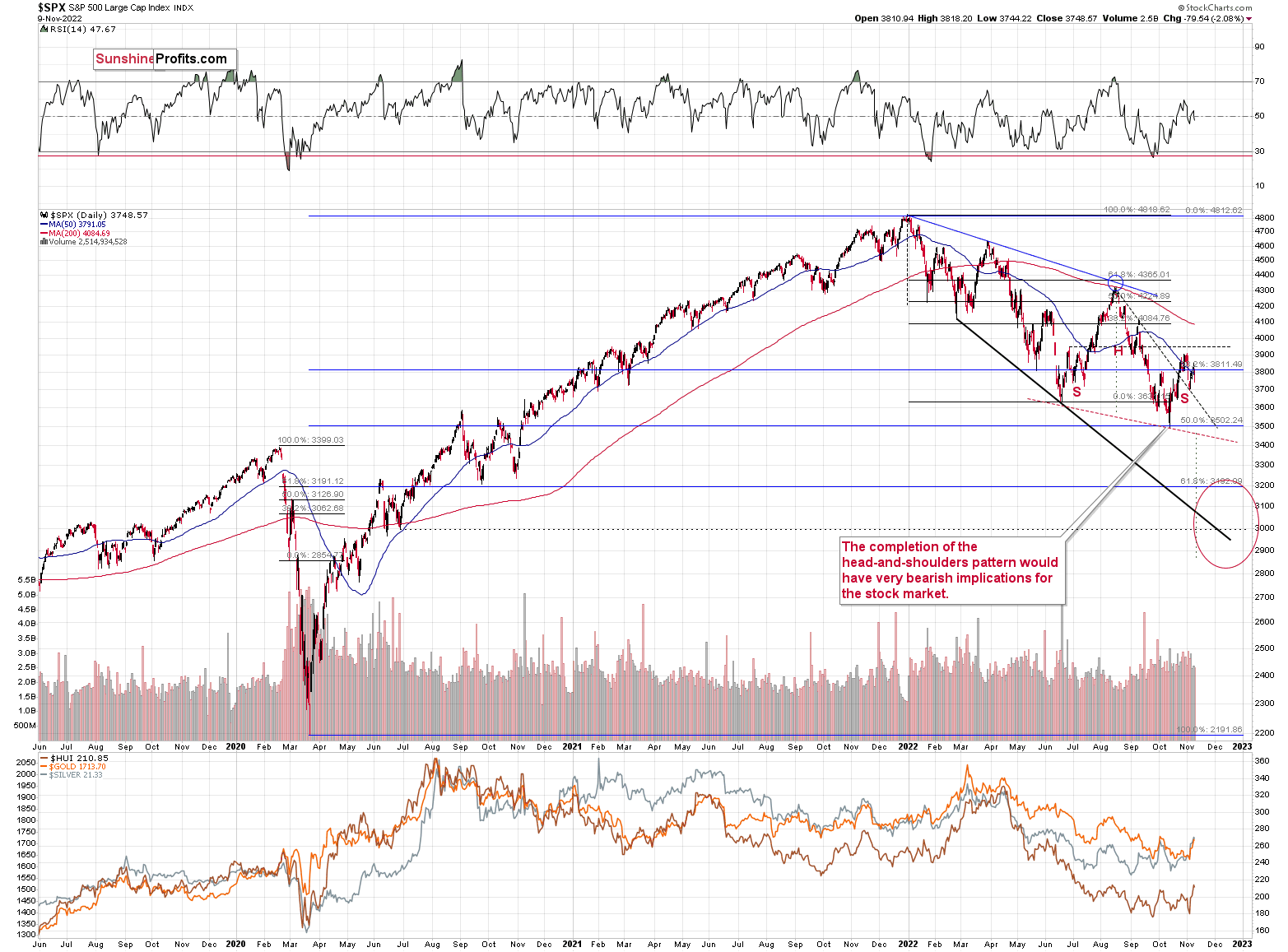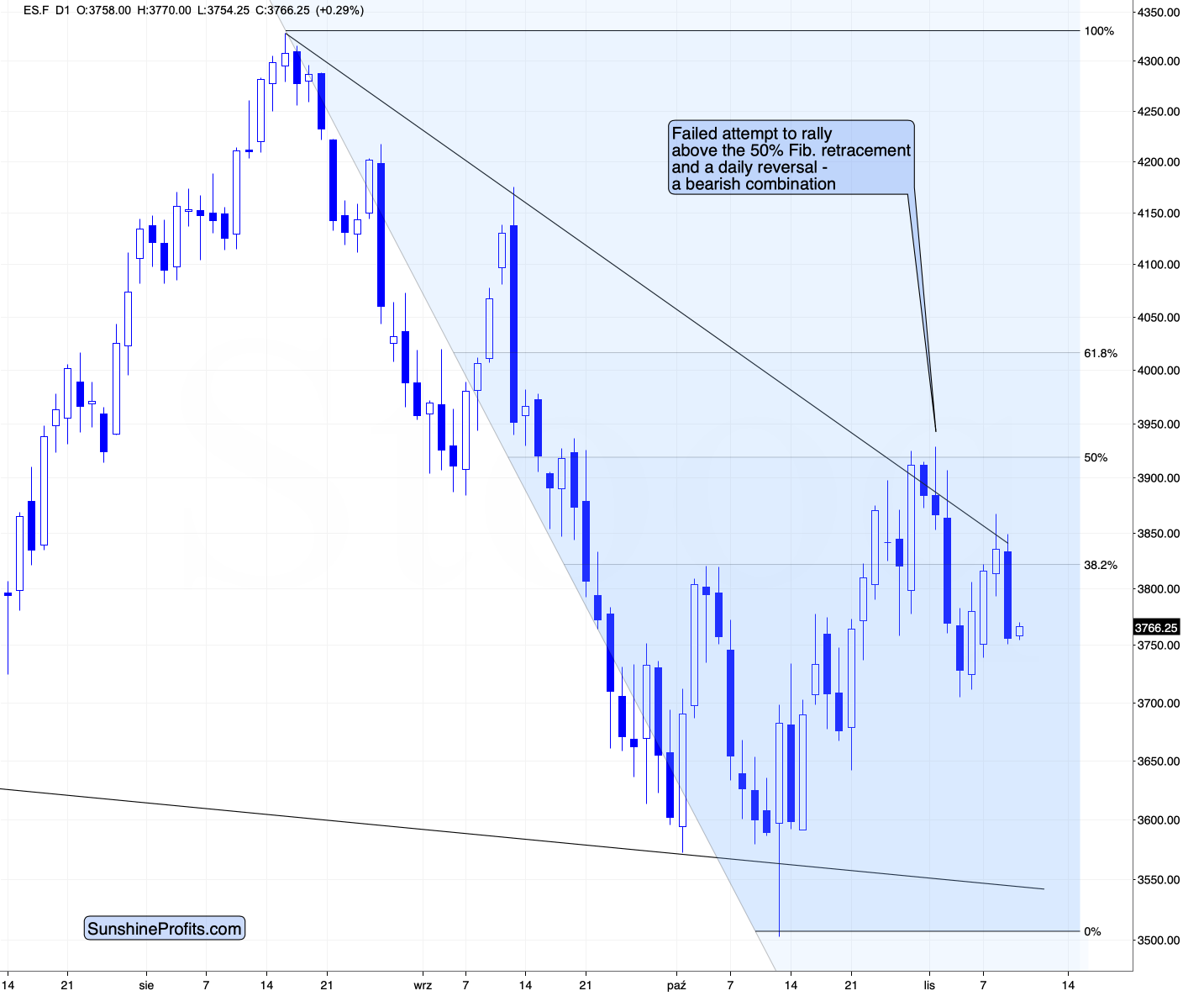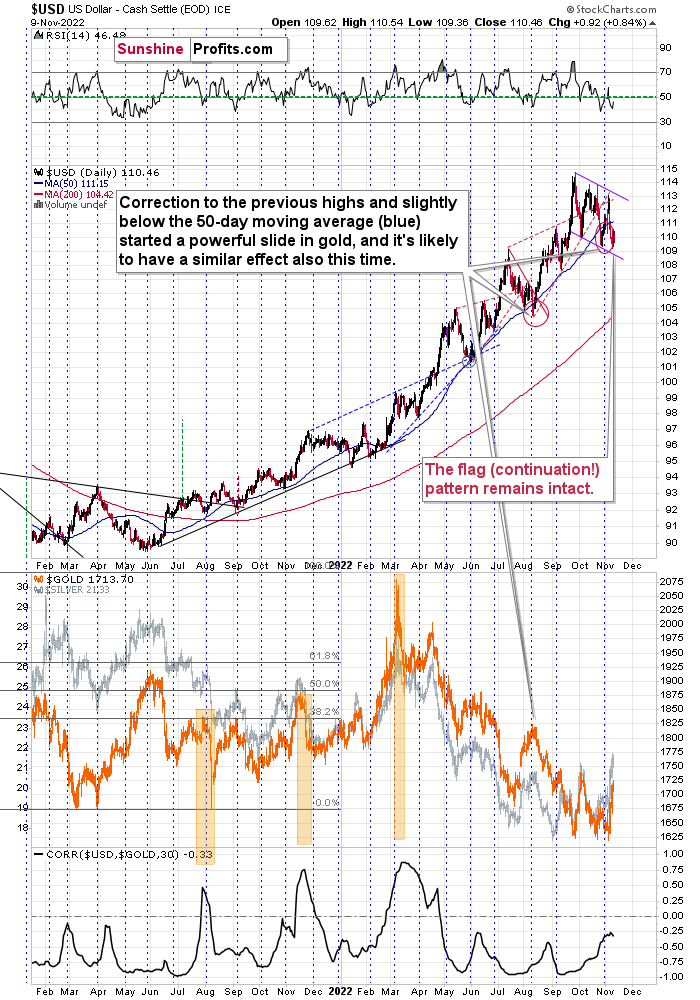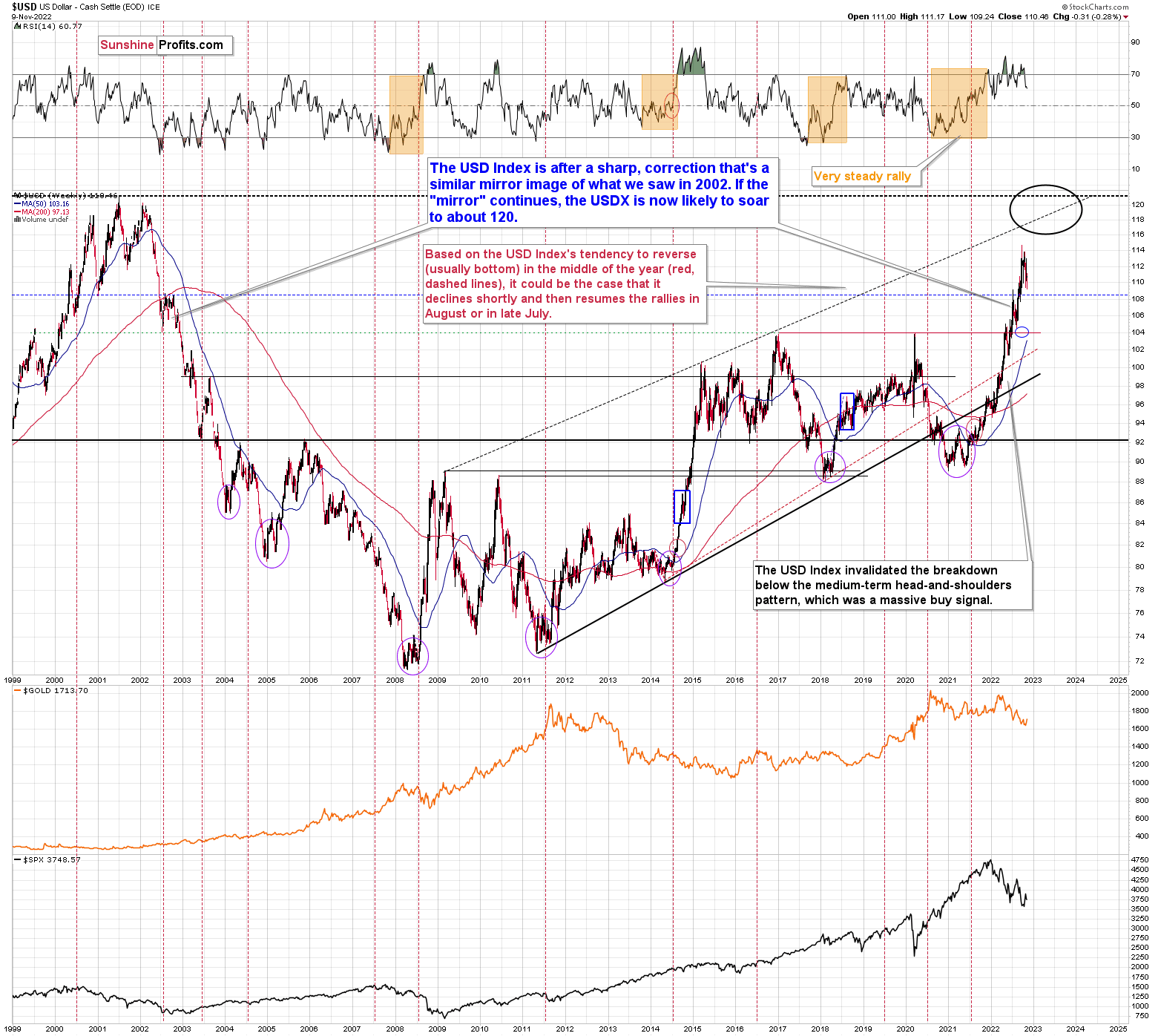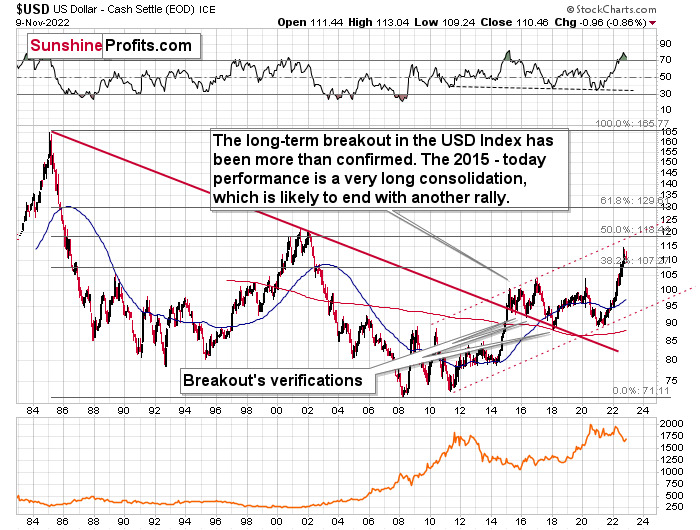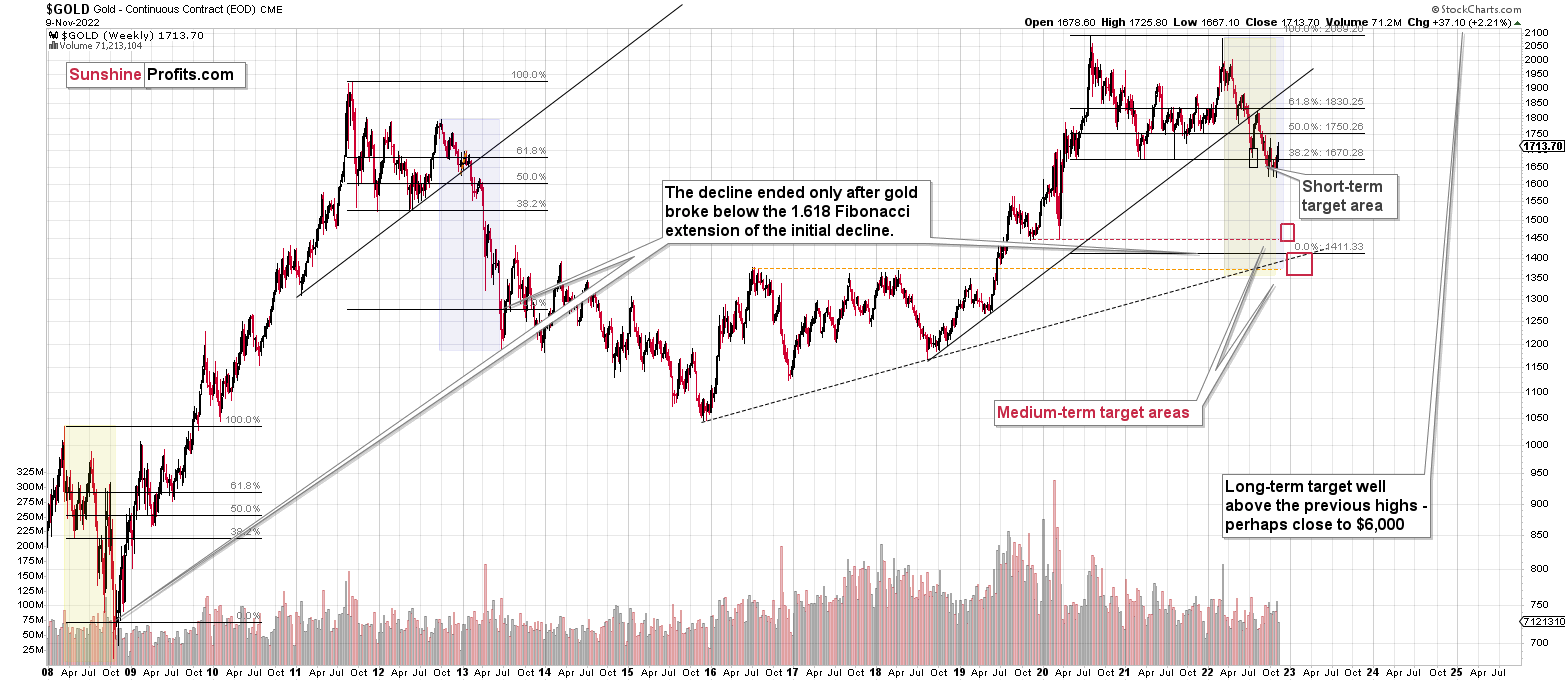Briefly: in our opinion, full (300% of the regular position size) speculative short positions in junior mining stocks are justified from the risk/reward point of view at the moment of publishing this Alert.
NOTE TO READERS:
Dear Subscribers,
Tomorrow’s analysis will focus on the fundamentals only, but if the outlook changes during the day, PR will send you an intraday follow-up.
Stay tuned!
Welcome to this week's flagship Gold & Silver Trading Alert. Predicated on last week’s price moves, our most recently featured (medium-term) outlook remains the same as the price moves align with our expectations (or at least not really against them). On that account, there are parts of the previous analysis that didn’t change at all in the earlier days, which are written in italics.
The key thing that we saw since I posted the previous flagship analysis is that gold rallied, but given the fundamental surrounding (U.S.-election-related uncertainty) it seems that this move was just as temporary as the post-2016-U.S.-election-based rally was.
Let’s start today’s analysis with a recap of what recently happened on the fundamental front.
The Weekly Fundamental Roundup
While the week began with short squeezes and misguided midterm optimism, the crypto bloodbath drowned risk appetite on Nov. 9. Initially, Binance reached a tentative deal to bail out FTX and provide the liquidity to meet customers’ redemption requests.
However, after the agreement collapsed on Nov. 9 due to “mishandled customer funds and alleged U.S. agency investigations” (according to Binance), Bitcoin and Ethereum plunged, and other ‘alt coins’ followed suit.
Please see below:
To explain, the red, green, and gray lines above track the five-minute movement of Bitcoin, Ethereum and Dogecoin versus the U.S. dollar. As you can see, heavy losses have confronted the crypto space in recent days.
More importantly, I warned before the opening bell on Nov. 9 that crypto weakness is often an ominous sign for the S&P 500 and the GDXJ ETF. I wrote:
The red line above tracks the four-hour movement of Bitcoin futures since late 2021, while the green line above tracks the four-hour movement of the S&P 500. If you analyze the vertical gray lines, you can see that when Bitcoin rolls over, the S&P 500 has either fallen in lockstep or declined soon after.
Conversely, if you analyze the right side of the chart, you can see that the green line has moved higher even as the red line falters; and while the stock bulls assume that the liquidity issues are isolated to crypto, the latter’s problems are a symptom of the fundamental medicine that’s required to cure inflation. As such, it’s likely only a matter of time before the fear cascades toward traditional assets.
To that point, the GDXJ ETF has largely followed Bitcoin’s path since late 2021.
Please see below:
Thus, with the S&P 500 and the GDXJ ETF declining by 2.08% and 3.04%, respectively, on Nov. 9, the crypto washout is highly bearish for risk assets. Remember, crypto investors – and apparently, the brokerages that transact them – use a lot of leverage; and when rapidly declining prices induce margin calls, they may sell other assets to raise the cash needed to post collateral.
As a result, the ramifications are negative for risk-on sentiment. Yet, the crypto crash is only a microcosm of the fundamental problems that should confront gold, silver, mining stocks and the S&P 500 in the months ahead.
Hello Volatility
With the Consumer Price Index (CPI) scheduled for release today, a weaker-than-expected print could result in a positive reaction from investors. In a nutshell: with crypto's plight killing the midterm rally, the crowd needs a new positive catalyst to pair with bullish seasonality. Therefore, volatility may be amplified in today's session.
However, while the bulls are so desperate for good news that a slowdown in the pace of rate hikes has become the new dovish pivot, hope is not an investment strategy. For example, Chicago Fed President Charles Evans said on Nov. 9:
“I do think there’s benefits to adjusting the pace as soon as we can.”
But he added:
“The path to getting to 2% [inflation] sooner means you’re willing to undershoot. I think in that world – where we undershoot inflation by a significant, meaningful amount – it might be hard to get it back up again, like it was before.”
So, while Evans is known to be dovish, his mention of "undershoot" highlights the Fed's position. To normalize inflation within a decent timeframe, the central bank needs to maintain a hawkish stance. If not, all that's left is to hope that inflation subsides – which is the same mistake officials made throughout 2021 and early 2022.
Please see below:
In contrast, Richmond Fed President Thomas Barkin parroted Fed Chairman Jerome Powell’s message on Nov. 9. He said:
“This slow return to normal levels of inflation could threaten the stability of inflation expectations (…). We are doing what it takes to get inflation back to our 2% target. That’s one place I can assure you we are headed back to normal.”
Furthermore, when noting that a rising U.S. federal funds rate (FFR) “may lead to a downturn” (remember, every inflation fight since 1954 has ended with a recession), he insisted that any economic weakness should not deter the Fed from achieving its inflation objective.
Please see below:
Likewise, while the crowd hopes that a dovish pivot will come sooner rather than later, the Fed has accomplished very little in its bid to curb inflation. In addition, even the dovish Fed members who preach caution build their arguments on the ‘hope’ that inflation will decelerate. As such, their rebuttals are no different than the “transitory” comments we heard in 2021.
In reality, the FFR will need to rise until growth craters or the U.S. labor market cracks, which means a ~5% peak may prove too low.
As evidence, the Atlanta Fed updated its Q4 real GDP growth projection on Nov. 9. An excerpt read:
“The GDPNow model estimate for real GDP growth (seasonally adjusted annual rate) in the fourth quarter of 2022 is 4.0 percent on November 9, up from 3.6 percent on November 3.”
Please see below:
To explain, the green line above tracks the Atlanta Fed’s Q4 real GDP growth estimate, while the blue line above tracks the Blue Chip (investment banks) consensus estimate. If you analyze the right side of the chart, you can see that 2.6% realized growth in Q3 (advanced estimate) has carried over into Q4. Therefore, the recent inflation, employment and GDP growth developments are nowhere near the levels that support a dovish pivot.
To that point, data from Hedgeye highlights how winning the inflation war often requires patience and economic weakness.
Please see below:
To explain, the heat map above depicts various peak-to-trough changes in the headline CPI. If you analyze the first row (Jun 2022), you can see that the year-over-year (YoY) percentage change in the headline CPI has only declined from a 9.1% peak to a 8.3% trough; and that’s only a change of 0.8% in three months.
Conversely, history shows that P-T changes in the headline CPI average 7.1% and often take 25 months. As a result, the Fed is far from this level of progress, and only the 1951-1952 drop occurred without a recession. Thus, the U.S. economy should endure much more weakness before inflation normalizes.
The Bottom Line
While the crowd searches for a new bullish thesis, the medium-term fundamentals remain profoundly bearish. Moreover, with the crypto collapse likely to persist as the liquidity drain unfolds, a higher FFR and quantitative tightening (QT) continue to wreak havoc when investors least expect them. However, these events are common symptoms of tighter monetary policy, and more bearish ‘surprises’ should occur in the months ahead.
In conclusion, the PMs declined on Nov. 9 as Bitcoin battered risk-on sentiment. Conversely, with the USD Index and the U.S. 10-Year real yield rising, their ascents should help push gold, silver, mining stocks, and the S&P 500 to lower lows in the months ahead. Therefore, we expect further downside before long-term buying opportunities emerge.
What to Watch for Next Week
With more U.S. economic data releases next week, the most important are as follows:
- Nov. 15: Producer Price Index (PPI)
With most commodities showcasing strength over the last month, it’s essential to monitor the effect on the PPI, since the metric often leads the CPI.
- Nov. 16: Retail sales
I warned for months that demand was a much larger component of the inflation story than most realized (and still is). So, Americans’ spending habits will go a long way in determining when inflation subsides.
- Nov. 17: Philadelphia and Kansas City Fed manufacturing indexes
The surveys only cover their respective regions' growth, inflation, and employment developments. However, they provide important insight into how different U.S. states are performing.
All in all, economic data releases impact the PMs because they impact monetary policy. Moreover, if we continue to see higher employment and inflation, the Fed should keep its foot on the hawkish accelerator. If that occurs, the outcome is profoundly bearish for the PMs.
Technically Speaking
Let’s start today’s technical discussion with a quick check of copper prices.
Overall, everything I wrote about it last week (and in the previous weeks/months) remains up-to-date:
Copper recently CLEARLY invalidated another attempt to move above its 2011 high. This is a very strong technical sign that copper (one of the most popular commodities) is heading lower in the medium term.
No market moves up or down in a straight line (well, the 2008 slide appears to have been an exception), and a short-term correction doesn’t necessarily invalidate the bigger trend. For the last couple of months, copper has been trading sideways, but it didn’t change much regarding the outlook.
In fact, it made my previous target area even more likely. You see, the consolidation patterns are often followed by a move that’s similar to the move that preceded them. In this case, the previous 2022 decline was quite significant, and if it is repeated, one can expect copper to decline well below 3.
Actually, copper could decline profoundly and bottom in the $2.0-2.4 area. That’s where we have rising, long-term support lines and also the previous – 2016 and 2020 – lows.
Interest rates are going up, just like they did before the 2008 slide. What did copper do before the 2008 slide? It failed to break above the previous (2006) high, and it was the failure of the second attempt to break higher that triggered the powerful decline. What happened then? Gold declined, but silver and mining stocks truly plunged.
Again, copper is after invalidation of a major breakout, a decline, and a correction. Copper prices currently SCREAM that it’s a variation of 2008 all over again. This is extremely bearish for mining stocks (especially juniors) and silver.
Having said that, let’s check junior miners’ really big picture.
I previously commented on the above chart in the following way:
The Toronto Stock Exchange Venture Index includes multiple junior mining stocks. It also includes other companies, but juniors are a large part of it, and they truly plunged in 2008.
In fact, they plunged in a major way after breaking below their medium-term support lines and after an initial corrective upswing. Guess what – this index is after a major medium-term breakdown and a short-term corrective upswing. It’s likely ready to fall – and to fall hard.
So, what’s likely to happen? We’re about to see a huge slide, even if we don’t see it within the next few days.
Having said that, let’s turn to gold.
Let’s start with context:
Between 2020 and now, quite a lot happened, quite a lot of money was printed, and we saw a war breaking out in Europe. Yet, gold failed to rally to new highs.
In fact, it’s trading very close to its 2011 high, which tells you something about the strength of this market. It’s almost absent.
Truth be told, what we see in gold is quite in tune with what we saw after the 2011 top, and in particular, shortly after the 2012 top. The long-term gold price chart below provides details.
Basically, the key thing about gold’s long-term chart is that it doesn’t show any important changes. The downtrend continues in tune with the 2013 price action, and the very recent rally is barely visible.
To clarify, it is visible, but what’s visible is still in tune with the final attempt for gold to rally in April 2013, right before the biggest part of the slide.
Gold is sometimes forced to react to some geo-political events as the safe-haven buying kicks in, but these moves are usually short-term lived. Looking at long-term charts helps to keep things in proper perspective.
Consequently, my previous comments remain up-to-date:
Based on the above chart, it’s quite clear that the situation that is now being repeated. The patterns marked with orange rectangles and blue ellipses are almost identical (also in the MACD indicator, and to a lesser extent in the RSI indicator).
Sure, the situations are not identical, as this time we had a Russian invasion of Ukraine that pushed gold temporarily higher. Other than that, the situations are extremely similar.
Based on the stage of the self-similarity and the confirmed breakdown below the $1,700 level, gold is now likely to slide.
Based on the analogy to 2013, it’s not only likely to slide, it’s likely to slide profoundly in a sharp manner. These may be the last days or hours before the slide fully begins.
How low is gold likely to go during this upcoming big medium-term decline? Perhaps as low as its 2020 low – to the $1,450-1,500 area. And then, after a rebound, quite likely to or slightly below $1,400.
I realize this is far from the current price, but nonetheless, this target area appears justified in my opinion. There are two important Fibonacci retracements based on the 2015-2020 rally that gold can bounce from (it recently bounced from the 38.2% retracement). These are 50% and 61.8% retracements.
The support provided by the 61.8% retracement is strengthened by the 2020 low and the support provided by the 50% retracement is strengthened by the 2019 high.
However, based on gold’s self-similarity to 2013, it seems that we’re about to see a slide that’s bigger than what we’ve been seeing so far this year. This time – based on the similarity – gold is likely to decline profoundly, but no longer in the back-and-forth mode. If gold formed its next local low at the 50% retracement (so at about $1,560), then it might do so still within the declining, short-term trend channel (sometime in September).
However, if gold is to stick to the link to 2013, then it should decline more rapidly. In this case, the technique that can help us estimate the short-term target is the one that says that after a breakdown from a trend channel, price is likely to move approximately by as much as the height of the previous trend channel. In this case, gold could break below the trend channel soon and then decline even more. Based on the height of the trend channel, the above means that a move to the 61.8% retracement as the next downside target is more likely than a move to the 50% retracement.
I previously wrote that the above-mentioned decline in gold would likely be linked to a breakdown in the EUR/USD below 1, and we already saw both: decline in gold, and a breakdown in the EUR/USD below 1. The implications remain bearish.
Let’s zoom in on what happened in 2013 after the analogous rebound.
Well, gold consolidated for a few weeks and plunged only after that consolidation.
That’s what we saw recently as well. Of course, we haven’t seen the big plunge yet, but the other parts of the recent price patterns are very, very similar to what we saw in 2013.
Still, let’s keep in mind that history doesn’t necessarily repeat itself to the letter – it rhymes. Consequently, it’s quite possible to have two (or three, depending on how one counts the Sep.-Nov. performance) corrections from the previous lows instead of just one.
Especially if the temporary (!) effect of geopolitical events practically forces gold to move up due to safe-haven demand.
In other words, on a more-or-less basis, gold is doing exactly what it’s been doing in April 2013, right before the biggest part of the slide.
This time, gold has been making a few attempts to break lower, as geopolitical news and rumors keep popping up. However, all they are able to trigger are rebounds, and those rebounds are getting smaller each time (the Oct.-Nov. rally is smaller than the Sep.-Oct. one). This is a bearish confirmation, as it tells us that the bulls’ strength and buying power are drying up. And when they finally give u, and the decline starts, there will be many people who are able to sell (after all, they had just bought recently), thus contributing to the decline’s volatility.
Having said that, let’s zoom in to see gold’s short-term price moves.
Gold moved sharply higher recently, and it even moved above its declining resistance line and its 50-day moving average (both marked with blue).
Will this breakout hold? The fundamentals behind it (as well as the all-important analogy to 2013) are temporary (U.S. midterm-election-based uncertainty), so it's doubtful.
Consequently, my yesterday’s comments on the above chart remain up-to-date:
Gold moved sharply higher after a short-term rally. The history tends to rhyme, so I doubt that yesterday’s price action is able to trigger a sustainable rally.
That was just a single daily close above the declining, medium-term resistance line (marked with blue), and the 50-day moving average. Will this breakout be confirmed? Again, I doubt it.
Interestingly, based on yesterday’s rally, the gold-based RSI moved slightly above 60. That’s exactly what happened back in 2016 after the U.S. Presidential elections. And that was a local top – right before a massive slide. Gold then declined by almost 16% in less than two following months.
If the same was to happen now, gold would move to about $1,450. And yes, that would be in perfect tune with my previous analyses. That’s where we have strong support based on the 2020 lows.
Let’s keep in mind that the two key fundamental drivers of gold price are: the real interest rates, and the USD Index.
The real interest rates are clearly headed higher (nominal rates are going up, and eventually inflation is likely to come down), which is bearish for gold.
Right now, gold continues to repeat its 2013 performance, which has extremely bearish implications for the coming weeks.
Having said that, let’s take a look at the silver market.
The key thing about the silver market remains its recent outperformance.
Yes, it appears bullish at first glance, but given my many years of experience on the precious metals market, I can tell you that this kind of performance (silver’s strength relative to gold) is rarely bullish. It’s usually the opposite. Silver soars and breaks above previous highs (or other important resistance lines) only to fool those who are new to this market. And then it slides.
It doesn’t have to happen each and every time, and I can’t guarantee any kind of performance, but the above really does have bearish implications right now.
As I explained in my Nov. 7 video, silver’s short-term outperformance is an important sell signal.
We saw this indication many times before, and it’s been one of the most reliable indications that the next big move lower is at hand. Remember the spike at the 2021 top, when silver soared relative to gold? Many people thought that silver was taking off and heading straight to the moon, but I warned that this was likely a fake move. And indeed, that was the top.
There were times to be long this year (for example, I went long miners on May 12 and on July 11 – very close to local bottoms). However, in my opinion, right now is not a good time to do so. Instead, it seems to me that profits from short positions are likely to grow substantially in the following weeks.
Moreover, let’s keep in mind that the entire July-now period can be viewed as one big flag pattern, and those “continuation patterns” tend to be followed by moves that are similar to the ones that preceded them.
In this case, the move that preceded the flag was a decline from about $28. This means that another move lower in silver is likely to be huge.
Once silver breaks below its 2022 lows, it has little support all the way until its 2020 low. There’s support just below $15, but it’s not very strong, so it might not trigger anything more than a brief correction.
Let’s keep in mind that while gold is repeating its 2013 performance, so is silver.
As you can see on the above chart, silver corrected about 50% of the previous downswing, and this correction ended at about $30, a long time ago. Ever since, silver has been declining, and even the outbreak of war in Europe didn’t make silver rally above that level.
On the above chart, you can see how silver first topped in 2011, then declined and formed another top at the cyclical turning point. Next, it declined once again – to the previous lows. After that, silver rallied (in 2012 and 2022), and it topped between its 50-week moving average (marked in blue) and the previous top. Now silver is declining in a back-and-forth manner (you can see it more clearly on the previous short-term silver chart).
Back in 2012, these were just the early days of a gargantuan decline, and the same appears likely to be the case this time. Interest rates are going up after all, and the Fed is determined to quench inflation.
Let’s not forget that rising interest rates are likely to negatively impact not just commodities, but practically all industries. This will likely cause silver’s price to decline profoundly, as silver’s industrial demand could be negatively impacted by lower economic growth (or a decline in economic activity).
Besides, please note that silver didn’t even manage to rally as much as copper (which tried to move to new highs recently) or most other commodities, thus being rather weak.
Consequently, it seems that silver will need to decline profoundly before it rallies (to new all-time highs) once again.
Having said that, let’s take a look at what happened in mining stocks.
History tends to repeat itself. Not to the letter, but in general. The reason is that while economic circumstances change and technology advances, the decisions to buy and sell are still mostly based on two key emotions: fear and greed. They don’t change, and once similar things happen, people’s emotions emerge in similar ways, thus making specific historical events repeat themselves to a certain extent.
For example, right now, gold stocks are declining similarly to how they did in 2008 and in 2012-2013.
As gold was practically forced to rally recently based on geo-political events, news, and rumors (and U.S.-midterm-election-based uncertainty), so were gold stocks.
Did it change anything technically?
Only a bit, and only at first sight.
The HUI Index is a bit above its rising resistance line, but it’s trading there after it already verified a breakdown below this line. Consequently, we would need to see a breakout’s confirmation for it to be really important.
Because the nature of the rally appears to be temporary, not only based on the analogy to 2013, but also on recent fundamental developments, I doubt that the breakout will be confirmed (as was the case with gold's short-term breakout).Please take a look at the stochastic indicator’s performance in the bottom part of the above chart. It’s currently doing practically the same thing that it did in 2008. And that – in 2008 – marked the final counter-trend top before the biggest part of the slide.
Is this time different? Those are expensive words on Wall Street.
How low can the HUI Index fall during the next big downswing?
As it’s the case with gold and silver, a move back to the 2020 lows is definitely in the cards. Please note that this level is also strengthened (as support) by other major lows: the 2019, 2014, and 2008 ones.
However, I wouldn’t rule out a move even lower on a temporary basis. If gold were to decline to about $1,450-1,500, it would mean that it would double its current 2022 decline. If the HUI Index does that, it will move below 150.
So, all in all, 120-150 is my current target area for the upcoming slide in the HUI Index.
All right, let’s zoom in and see how mining stocks declined in 2008.
Back then, the GDXJ ETF was not yet trading, so I’m using the GDX ETF as a short-term proxy here.
The decline took about 3 months, and it erased about 70% of the miners’ value. The biggest part of the decline happened in the final month, though.
However, the really interesting thing about that decline – that might also be very useful this time – is that there were five very short-term declines that took the GDX about 30% lower.
I marked those declines with red rectangles. After that, a corrective upswing started. During those corrective upswings, the GDX rallied by 14.8-41.6%. The biggest corrective upswing (where GDX rallied by 41.6%) was triggered by a huge rally in gold, and since I don’t expect to see anything similar this year, it could be the case that this correction size is an outlier. Not paying attention to the outlier, we get corrections of between 14.8% and 25.1%.
Fast forward to the current situation. Let’s take a look at the GDXJ ETF.
The junior mining stocks moved sharply higher recently, and this move took place on huge volume (I spoke about it on Nov. 7). The only similarly big volume that we saw recently was at the early-March top and the January top. As history tends to rhyme, this kind of massive attention that junior miners got serves as a bearish indication.
Back in 2008, the biggest corrective upswing (the 41.6% rally) was the thing that preceded the biggest part of the medium-term decline.
This time, the volatility is not as big, but the size of the corrective upswing (assuming that it started in September) that we just saw is also greater than what we’ve seen before. Consequently, it could be the case that what happened recently is what “had to” happen given the way history decided to rhyme. Please note that we can estimate what is likely to happen based on historical analogies, but we can never be 100% certain that a given analogy will work and some others won’t.
In this case, it seems that the correction happened, even though it didn’t “have to” happen based on many other techniques. Either way, the medium-term trend remains down, so the current corrective upswing is likely to be a “thing of the past of little meaning” sooner rather than later.
Speaking of analogies, I previously wrote that the current rally is a mirror image (it’s not a crystal-clear mirror, though) of the corrective decline that we saw in late-March 2020. As it turned out, due to the most recent part of the upswing, the size of both moves became even more aligned.
And yes, this means that another decline could take the GDXJ all the way down to its 2020 low, or very close to it.
At this point, you might be wondering why junior miners are not trading at their previous 2022 lows, just like gold is, and what does this “strength” mean.
In short, it’s most likely due to the stock markets’ performance. It rallied recently, and some of the bullishness spilt over to mining stocks. What does it imply?
Well, as the stocks are likely to slide, the small bullish impact is likely to turn into a huge bearish impact. And if stocks don’t slide, but rally instead, then juniors are still likely to decline more than gold and silver in percentage terms, but their decline would not be as dramatic in this case.
In my view, a decline in stocks is still the most likely outcome – and I think that junior miners will be affected to a great extent. And yes, this means that I expect (no promises, of course) that our profits on the short positions in junior mining stocks are going to soar in the coming weeks.
Meanwhile, the relative performance of junior miners compared to senior miners continues to deteriorate in a medium-term trend.
During this quick upswing, juniors rallied relative to seniors, but this is just a very short-term move that’s within a short-, and medium-term downtrends.
This implies bigger declines in the GDXJ in the future.
Also, let’s not forget about the forest while looking at individual trees. By that, I mean looking at how gold stocks perform relative to gold. That’s one of the major indications that the current situation is just like what we saw at the 2012 top.
The situation in the gold stock to gold ratio is similar to what we saw in late 2012 and early 2013. The HUI to gold ratio invalidated its first attempt to break lower (marked with red, dashed lines), but after a corrective upswing, it then broke lower more decisively. That’s what I marked using black, dashed lines.
Recently, we saw a quick upswing in the ratio, but that’s not a game-changer – even the biggest declines had quick corrections in the past.
If history is to rhyme, we’re about to see a profound decline. In fact, we’re likely already past its beginning.
Also, please note that the pattern that we currently see, which started in early 2016, is somewhat similar to what happened between 2003 and 2008.
Back in 2008, the breakdown from the consolidation resulted in sharply lower ratio values and much lower prices of gold stocks.
So, if the situation is analogous to 2012-2013, we’re likely to see a big decline in the following weeks/months, and if it’s analogous to 2008, we’re likely to see an enormous decline in the following weeks/months.
Declining stock prices would only add fuel to the bearish fire (after all, gold stocks are… just stocks) and that’s exactly what’s likely to happen.
The technical picture in the case of world stocks remains extremely bearish, and my previous comments on it were just confirmed.
After a brief pause, the freefall continues, just like in 2008. This has profoundly bearish implications for the mining stocks that declined severely back then.
Here’s what I’ve been writing about the above chart for quite a few weeks now:
World stocks have already begun their decline, and based on the analogy to the previous invalidations, the decline is not likely to be small. In fact, it’s likely to be huge.
For context, I explained the ominous implications on Nov. 30. I wrote:
Something truly epic is happening in this chart. Namely, world stocks tried to soar above their 2007 high, they managed to do so, and… failed to hold the ground. Despite a few attempts, the breakout was invalidated. Given that there were a few attempts and that the previous high was the all-time high (so it doesn’t get more important than that), the invalidation is a truly critical development.
It's a strong sell signal for the medium - and quite possibly for the long term.
From our – precious metals investors’ and traders’ – point of view, this is also of critical importance. All previous important invalidations of breakouts in world stocks were followed by massive declines in mining stocks (represented by the XAU Index).
Two of the four similar cases are the 2008 and 2020 declines. In all cases, the declines were huge, and the only reason why they appear “moderate” in the lower part of the above chart is that it has a “linear” and not a “logarithmic” scale. You probably still remember how significant and painful (if you were long, that is) the decline at the beginning of 2020 was.
All those invalidations triggered big declines in the mining stocks, and we have “the mother of all stock market invalidations” at the moment, so the implications are not only bearish, but extremely bearish.
World stocks have declined below their recent highs, and when something similar happened in 2008, it meant that both stocks and gold and silver mining stocks (lower part of the chart) were about to slide much further.
The medium-term implications for mining stocks are extremely bearish.
However, let’s get back to the short- and medium-term points of view.
Stocks are after quite a volatile short-term decline, and based on how the prices shaped in the previous months, it could be the case that the right shoulder of a medium-term head-and-shoulders pattern is being formed.
If this pattern is completed – that appears likely in my view – the implications will be very bearish for the short term. Not just for the stock market but also for mining stocks (particularly juniors).
Another thing that could serve as a sell signal in the near future is an invalidation of the breakout above the declining black dashed resistance line. Interestingly, this breakout is only visible when we look at the index itself, but it’s not visible in the case of the index futures.
I commented on it on Nov. 2 in the following way:
However, once we zoom in and focus on S&P 500 index futures, it becomes clear that the situation is much more bearish than it seems at first glance.
The index futures have longer trading hours than the index, so the above chart includes a broader data range. In many cases, the U.S. session would be key and overnight trading wouldn’t be that important, but in the case of the S&P 500 index futures, those trades are important as this extremely popular index/futures is being traded all over the world, and the sizes of those transactions are not minor.
In other words, paying attention to the S&P 500 index futures is a good idea.
The above chart shows that we just saw a failed attempt to break above the declining resistance line, the October highs, and the 50% Fibonacci retracement based on the August-October decline. This is a powerfully bearish combination.
On top of that, yesterday’s session took the form of a daily reversal.
And yes, this is all bearish news for the stock market.
This, in turn, means that the positive impact that the stock market had on the prices of mining stocks is likely to be reversed. This, plus the bearish implications of gold and silver charts, tells us that the very bearish outlook for mining stocks (especially junior mining stocks) remains up-to-date – at least for the next few weeks-months. In my view, they are likely to rally in the very long run, but not without a bigger decline first.
Indeed, stocks declined shortly thereafter, and technical indications preceded fundamental developments (FOMC), as it’s often the case.
This is yet another example of why it’s a great idea to examine the charts for clues instead of passively waiting for the news to hit the market, or why it’s worthwhile to try to guess what kind of news will appear. Sometimes, the latter is useful, but chart analysis is useful almost at all times.
Every now and then I’m being asked “what if” questions, and the “what if” is followed by a scenario that is almost obviously going to make the market move in a way that’s unfavorable to the current position. In almost all cases, the reply is about comparing what’s possible and what’s likely. Just because something is possible (you could be hit by a meteor made of gold the second you get outside) doesn’t make it likely. The reason we’re analyzing charts so thoroughly (and why we cover so many of them – actually, I look at many more charts than I feature even in the longest analyses) is to estimate what’s likely before any type of news hits the market.
After all, if the market wants to move in a certain way, it will just more or less ignore news that pushes it in the other direction while magnifying its reactions to the news that push it in the direction it wants to move.
Please note that it would have been “unfortunate” for stocks to decline right before the U.S. elections. Consequently, it could have been the case that the market was kept up more or less artificially until “after the elections”. This means that juniors’ performance might have been affected as well. And, well, we are “after the elections”, so things can get back to normal now. And this means lower stock and junior mining stock valuations.
As interest rates are likely to go up, the stock market is likely to go down – perhaps as low as 3,200 on a short-term basis – and then – after a correction – even lower.
Most interestingly, though, such a decline would likely have a devastating effect on the prices of mining stocks (especially junior mining stocks) and silver. There might be some impact on gold, too.
The above would also be in tune with an extra rally in the USD Index. After all, less competitive exports are not that favorable for the U.S. economy.
In short, the USD Index remains in its flag pattern that started in September. A flag pattern is a continuation pattern where the price trades sideways (but slightly against the trend) and it continues… until it doesn’t. Quite often, the pattern ends after two or three bottoms. We already had two, and it seems that the third one is about to be formed or it has already formed.
The RSI is slightly below 50 and the USDX itself is a bit below its 50-day moving average (blue line). In the previous months, this combination of factors meant that another sizable rally was just around the corner. As history tends to rhyme, the implications are bullish.
Since March, gold has been moving in the opposite direction to the USD Index, so the implications of the above are bearish for gold and the rest of the precious metals sector.
Why wasn’t gold moving against the USD Index in February? Because of the fear and uncertainty related to the Russian invasion of Ukraine. Please note that the war in Ukraine is still in place, and yet, gold is hundreds of dollars below its 2022 high. This serves as a strong confirmation of gold’s current weakness.
From the long-term point of view, the USD Index is currently rallying in approximately the mirror image of how it declined in 2002. Based on this, it seems that one shouldn’t be surprised by a rather quick move from the current levels to about 120 – USD Index’s long-term highs. Of course, the implications for the precious metals market are profoundly bearish.
This doesn’t rule out quick corrections along the way – those don’t interrupt the big, weekly/monthly moves at all, and they don’t break the analogy. This includes the recent downswing – it didn’t invalidate the bullish medium-term uptrend.
This is extremely bearish for gold and the rest of the precious metals sector.
Before summarizing, do you remember the very, very long-term USD Index chart that I’ve been featuring for many months? The one below.
I emphasized that the USD Index was after a major breakout (in 2014/2015) that was then followed by a multi-year consolidation. The breakout was also verified in late 2017 / early 2018, when the USD Index moved back to the previously broken resistance line, and it verified it as support.
After that, it was only a matter of time before we saw a huge upswing. It certainly took a while, but the massive rally has indeed followed.
The reason why I’m mentioning this today is not to provide you with told-ya-so comments, but to emphasize that this big rally has legs. Strong legs.
On a day-to-day basis, it might seem unbelievable, temporary, random, or based on some sort of manipulation. But in reality, the writing has been on the wall for – literally – years! And those who have been following my analyses in the past were well-prepared – well in advance.
What does it tell us now? It tells us two things:
- The move to the 118 – 120 area is quite likely as there is little other strong resistance nearby.
- The top close to 118 – 120 might not be the final top for the USD Index. It could rally further (after a corrective decline from the above-mentioned area), but this might not necessarily mean that gold will decline in the following years (beyond the medium-term decline to $1,400 or so).
All in all, the outlook for the USD Index remains bullish, which has bearish implications for the medium term, but I don’t think it will prevent the precious metals market from rallying in the long run.
Overview of the Upcoming Part of the Decline
- It seems to me that the corrective upswing is over (or about to be over) and that the next big move lower is already underway (or that it’s about to start).
- If we see a situation where miners slide in a meaningful and volatile way while silver doesn’t (it just declines moderately), I plan to – once again – switch from short positions in miners to short positions in silver. At this time, it’s too early to say at what price levels this could take place and if we get this kind of opportunity at all – perhaps with gold prices close to $1,500 - $1,550.
- I plan to switch from the short positions in junior mining stocks or silver (whichever I’ll have at that moment) to long positions in junior mining stocks when gold / mining stocks move to their 2020 lows (approximately). While I’m probably not going to write about it at this stage yet, this is when some investors might consider getting back in with their long-term investing capital (or perhaps 1/3 or 1/2 thereof).
- I plan to return to short positions in junior mining stocks after a rebound – and the rebound could take gold from about $1,450 to about $1,550, and it could take the GDXJ from about $20 to about $24. In other words, I’m currently planning to go long when GDXJ is close to $20 (which might take place when gold is close to $1,450), and I’m planning to exit this long position and re-enter the short position once we see a corrective rally to $24 in the GDXJ (which might take place when gold is close to $1,550).
- I plan to exit all remaining short positions once gold shows substantial strength relative to the USD Index while the latter is still rallying. This may be the case with gold prices close to $1,400 and GDXJ close to $15 . This moment (when gold performs very strongly against the rallying USD and miners are strong relative to gold after its substantial decline) is likely to be the best entry point for long-term investments, in my view. This can also happen with gold close to $1,400, but at the moment it’s too early to say with certainty.
- The above is based on the information available today, and it might change in the following days/weeks.
You will find my general overview of the outlook for gold on the chart below:
Please note that the above timing details are relatively broad and “for general overview only” – so that you know more or less what I think and how volatile I think the moves are likely to be – on an approximate basis. These time targets are not binding nor clear enough for me to think that they should be used for purchasing options, warrants, or similar instruments.
Summary
Summing up, it seems that the biggest part of the 2013-like decline is taking place right now, and – while I can’t make any promises regarding performance - it seems likely to me that our big profits are about to become huge and then ridiculously big in the relatively near future.
As I have written before, the recent upswing didn’t change anything. While the mining stocks appeared “strong” recently, it seems to me that it’s just a reflection of the temporary (in my view) strength in the general stock market. And as stocks decline, mining stocks – and especially junior mining stocks – are likely to truly slide.
Things might happen very fast in the coming days, and if I plan to make any adjustments, I’ll keep you informed. Still, if the targets that I’m mentioning in the “Trading” part of the summary are reached, I think that profits should be taken off the table without an additional confirmation from me. I will probably get on the long side of the market at that time, but I’ll send a confirmation if I decide to do so.
After the final sell-off (that takes gold to about $1,350-$1,500), I expect the precious metals to rally significantly. The final part of the decline might take as little as 1-5 weeks, so it's important to stay alert to any changes.
As always, we'll keep you – our subscribers – informed.
To summarize:
Trading capital (supplementary part of the portfolio; our opinion): Full speculative short positions (300% of the full position) in junior mining stocks are justified from the risk to reward point of view with the following binding exit profit-take price levels:
Mining stocks (price levels for the GDXJ ETF): binding profit-take exit price: $20.32; stop-loss: none (the volatility is too big to justify a stop-loss order in case of this particular trade)
Alternatively, if one seeks leverage, we’re providing the binding profit-take levels for the JDST (2x leveraged). The binding profit-take level for the JDST: $27.87; stop-loss for the JDST: none (the volatility is too big to justify a SL order in case of this particular trade).
For-your-information targets (our opinion; we continue to think that mining stocks are the preferred way of taking advantage of the upcoming price move, but if for whatever reason one wants / has to use silver or gold for this trade, we are providing the details anyway.):
Silver futures downside profit-take exit price: $12.32
SLV profit-take exit price: $11.32
ZSL profit-take exit price: $74.87
Gold futures downside profit-take exit price: $1,504
HGD.TO – alternative (Canadian) 2x inverse leveraged gold stocks ETF – the upside profit-take exit price: $18.47
HZD.TO – alternative (Canadian) 2x inverse leveraged silver ETF – the upside profit-take exit price: $46.87
Long-term capital (core part of the portfolio; our opinion): No positions (in other words: cash)
Insurance capital (core part of the portfolio; our opinion): Full position
Whether you’ve already subscribed or not, we encourage you to find out how to make the most of our alerts and read our replies to the most common alert-and-gold-trading-related-questions.
Please note that we describe the situation for the day that the alert is posted in the trading section. In other words, if we are writing about a speculative position, it means that it is up-to-date on the day it was posted. We are also featuring the initial target prices to decide whether keeping a position on a given day is in tune with your approach (some moves are too small for medium-term traders, and some might appear too big for day-traders).
Additionally, you might want to read why our stop-loss orders are usually relatively far from the current price.
Please note that a full position doesn't mean using all of the capital for a given trade. You will find details on our thoughts on gold portfolio structuring in the Key Insights section on our website.
As a reminder - "initial target price" means exactly that - an "initial" one. It's not a price level at which we suggest closing positions. If this becomes the case (as it did in the previous trade), we will refer to these levels as levels of exit orders (exactly as we've done previously). Stop-loss levels, however, are naturally not "initial", but something that, in our opinion, might be entered as an order.
Since it is impossible to synchronize target prices and stop-loss levels for all the ETFs and ETNs with the main markets that we provide these levels for (gold, silver and mining stocks - the GDX ETF), the stop-loss levels and target prices for other ETNs and ETF (among other: UGL, GLL, AGQ, ZSL, NUGT, DUST, JNUG, JDST) are provided as supplementary, and not as "final". This means that if a stop-loss or a target level is reached for any of the "additional instruments" (GLL for instance), but not for the "main instrument" (gold in this case), we will view positions in both gold and GLL as still open and the stop-loss for GLL would have to be moved lower. On the other hand, if gold moves to a stop-loss level but GLL doesn't, then we will view both positions (in gold and GLL) as closed. In other words, since it's not possible to be 100% certain that each related instrument moves to a given level when the underlying instrument does, we can't provide levels that would be binding. The levels that we do provide are our best estimate of the levels that will correspond to the levels in the underlying assets, but it will be the underlying assets that one will need to focus on regarding the signs pointing to closing a given position or keeping it open. We might adjust the levels in the "additional instruments" without adjusting the levels in the "main instruments", which will simply mean that we have improved our estimation of these levels, not that we changed our outlook on the markets. We are already working on a tool that would update these levels daily for the most popular ETFs, ETNs and individual mining stocks.
Our preferred ways to invest in and to trade gold along with the reasoning can be found in the how to buy gold section. Furthermore, our preferred ETFs and ETNs can be found in our Gold & Silver ETF Ranking.
As a reminder, Gold & Silver Trading Alerts are posted before or on each trading day (we usually post them before the opening bell, but we don't promise doing that each day). If there's anything urgent, we will send you an additional small alert before posting the main one.
Thank you.
Przemyslaw K. Radomski, CFA
Founder, Editor-in-chief


